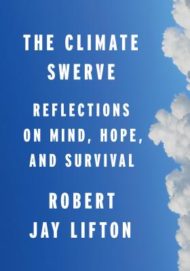 Robert Jay Lifton
Robert Jay Lifton
The New Press ($22.95)
by Robert Zaller
Robert Jay Lifton set out long ago to be our catastrophist: the chronicler of the grim age of the twentieth century that included the two most terrible wars in history, and, with the advent of the atomic bomb, of a climate of terror that promises worse wars to come, if not a final one; the nightmare of totalitarian regimes that threatened human personality itself; the rise of apocalyptic cults and global terrorism; and the rupture of generational continuity that gave final meaning to individual lives. Lifton is probably still best known for his Death in Life: Survivors of Hiroshima, but he has studied Nazi doctors, Chinese brainwashing, and the consequences, dehumanizing to victims and perpetrators alike, of what he has called “the genocidal mentality.”
Lifton is now in his nineties, and the century whose horrors he set out to record has passed into a new and no less ominous one. “Nuclearism,” as he has called it, is still very much with us, as the recent brinksmanship between Kim Jong-un and Donald Trump reminds us, but the cloud that hangs most threateningly over us now is that of climate change. We didn’t need to break the atom to produce this cloud, but merely to poison the planetary environment, an insidious and largely invisible process glibly identified with progress and civilization.
Much of this devastation was accomplished in the twentieth century, as the human population—world wars notwithstanding—quadrupled, not only ransacking the planet’s resources and threatening its biodiversity, but creating in hyper-urbanization huge engines of consumption and pollution. Now, looking back, Lifton confesses to having come late to the climate story, although in retrospect the markers for him, as for all of us, were clearly there. But the hubris that gave us the century’s other disasters is, he contends, very much of a piece with one that preoccupies us now, and the mentality that produced genocide and nuclearism has given us our current crisis as well.
As Lifton points out, the story of nuclear proliferation has several points of affinity with the seemingly more diffuse narrative of climate change. In both cases, a sense of fated disaster has fit, especially although not exclusively in the Western mind, with apocalyptic expectations foreshadowed in sacred texts: the expulsion from the Garden of Eden and Noah’s flood in the Old Testament—both tales of climate catastrophe in substantial part—and the Second Coming in the Gospels, with its presumption of an end to the terrestrial sphere altogether. Both the threat of a nuclear winter conjured up in the 1980s and the scenario of a world unhinged by rising sea levels and wild swings of temperature and precipitation seem to mirror (or for certain groups, to fulfill) the biblical prophecies. But, just as these latter have been interpreted as part of an ultimately beneficent divine dispensation, so, too, have “nuclearism” and climate change been embraced as potential opportunities and even as agents of good. Some hailed nuclear weapons as guarantors of world peace, since they were plainly too terrible to use; similarly, others now see climate change as a challenge to technological innovation and resource management. In both cases, the solution for the monsters created by modern science is more science.
At one extreme, the global crises of the bomb and the greenhouse effect lead to what Lifton calls psychic numbing, in which perils are minimized by wishful thinking; thus, the duck and cover drills of the 1950s in the U.S.A., in which schoolchildren were taught to hide under desks as protection against nuclear fireblasts and contamination, or, in the case of the noted physicist Freeman Dyson (a fervent advocate, as Lifton notes, of nuclear disarmament) the idea that the carbonization of the atmosphere will on balance be “enormously beneficial.” Then, too, there are the proponents of what Lifton calls climate nuclearization, in which reliance on nuclear power will solve the climate crisis, a position championed by James Hansen, the NASA scientist who first brought the latter to public attention in 1988. To be sure, militarists and energy profiteers have cynically argued that ever-expanding nuclear arsenals and unchecked carbonization are good for us; but that otherwise serious and reputable people make similar claims should give us pause. Psychic numbing is a very ancient mechanism, even in the minds of highly intelligent people: if reality frightens or offends you, deny it.
Lifton’s book could easily fit into this literature as well, but, as he points out, concluding that nothing can be done about seemingly overwhelming or intractable problems is itself a form of denial. The climate “swerve” of his title refers to is the emerging awareness over the past thirty years of the great ecological crisis we face, emblematized in the Paris Climate Accords. Nuclear weapons, to be sure, are still with us, but not, thanks to disarmament activists, the fatalism that once surrounded their inevitable use. It is easy to succumb to despair, but, Lifton says, the two-footed mammal that calls itself human has overcome innumerable obstacles in its career thus far, and the skills of awareness and adaptability that have created our current predicaments may yet with wisdom solve or at least mitigate them: “Of course it is very late in the game,” he concedes, “but at the same time far from too late.”
The Climate Swerve is, frankly, not a book that encourages hope. But if its nonagenarian author does not reject it, perhaps the rest of us can hang on to some too.
